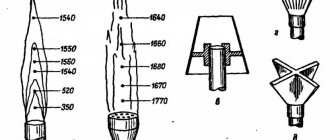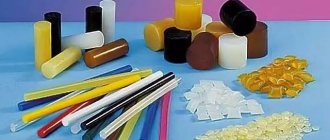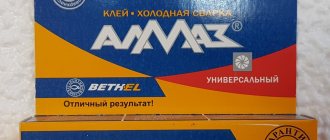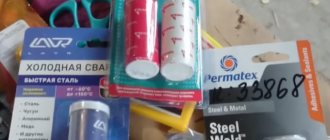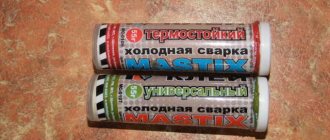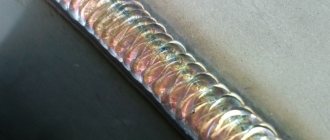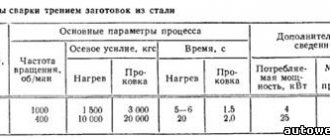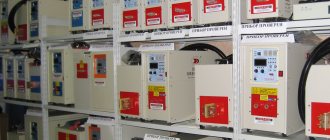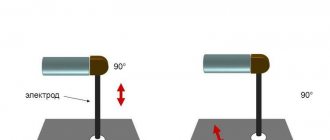Characteristics and composition of cold welding
The main characteristics of cold welding are:
- Presence and composition of filler.
- The initial drying time is the so-called time. “setting”, during this time the composition must be applied to the gluing area and leveled.
- Final curing time - the product cannot be used before this period.
- Application temperature - the recommended temperature at which the mixture can be applied to the surface.
- Maximum operating temperature.
The plastic cold seal adhesive composition can consist of one or two components. Its required components are:
- The adhesive base is in the form of epoxy resin, which determines the plastic properties.
- The filler is metal powder, evenly distributed throughout the volume.
- Quality improving additives, such as sulfur.
The quality of a weld obtained by cold welding depends on conditions such as:
- Quality of adhesive material.
- Preparing the surfaces of parts for gluing.
- Compliance with technology.
The strength of the resulting seam in real conditions will be lower than that of a seam produced by the hot method.
Therefore, the technology is best applicable for local repairs of lightly loaded products.
Terms of Use
In order to use one or another type of cold welding, you need to know several of its properties. However, the most important property that must be taken into account is the maximum temperature at which the compound will not lose its properties.
The connection is subject to the maximum level of danger in the first couple of hours after its creation.
During this time, as a rule, only primary drying occurs, so the repaired substance cannot yet be used. The product will be able to perform its functions again only after twenty-four hours. As a rule, the maximum possible temperature of use is indicated on the packaging of the substance.
It is important to know: the maximum temperature that a universal-type cold weld connection from one manufacturer can withstand may differ from the same type of substance from another brand.
For example, popular brands of welding such as Poxipok, Abro, Hi-Gear are able to withstand temperatures of approximately 250-270 degrees Celsius, and Almaz cold welding can be used without problems at temperatures above one thousand degrees.
How to use cold welding correctly
To obtain a good seam, careful execution of the following steps is of utmost importance:
Technological process of cold welding
- Clean the bonded surfaces from oil, fat and mechanical contaminants. Cleaning can be mechanical (abrasives, steel brush), chemical (solvents and degreasers) and combined.
- All actions are carried out only in protective gloves.
- Squeeze the two-component composition out of the tubes and mix the components well.
- Separate the required amount of plasticine-shaped composition from the block with a spatula and carefully close the remaining block.
- Knead the composition. It should heat up slightly, maintaining plasticity; once the required consistency is achieved, apply the mixture to the surfaces to be glued.
- Securely press the surfaces together by wrapping the parts with an elastic band.
- If pipes are being repaired, the composition must be applied with several smoothing movements.
- After the time specified in the technical specifications as the initial drying time (90% of the glue sets), the tourniquet can be removed.
- The repaired product can only be used after the final hardening time has passed, usually 24 hours.
It is better to remove the remaining adhesive with a spatula after applying and applying the tourniquet. If they have already hardened, they can be removed by lightly tapping them with a hammer.
Temperature characteristics
The composition of the adhesive mass determines what temperature cold welding can withstand. The user manual always states this value. If you carefully follow all the requirements of the manual, the seam will withstand this temperature without loss of strength.
Budget brands are usually developed for a maximum temperature of around 260 C. Special types of mixtures have a maximum operating temperature of over 1300 C. They cost significantly more, but they allow you to repair parts and products operating at high temperatures. This is an excellent help if the use of hot technology is difficult for reasons of fire safety or accessibility of the repair site.
What is the maximum temperature that cold welding can withstand?
Modern technologies do not stand still. Until relatively recently there was no such thing as cold welding. However, even now many people are not aware of the existence of such material. In fact, only the name remains from classical welding in this substance. In fact, cold welding is nothing more than glue. True, it is not ordinary, it can hold together almost any materials, and it is not necessary that they be strictly homogeneous.
Such wide application possibilities lead many people to wonder about the maximum possible temperature that cold welding can withstand. A large number of parts, most often metal, when performing their task, encounter fairly high temperatures; accordingly, if the temperature exceeds the value that a connection created using cold welding can withstand, its strength will be maintained for a very short period of time.
Cold welded joints, of course, cannot be compared in strength to classical ones. However, it is quite suitable for repairing plumbing fixtures, cars, household items, etc. A distinctive feature of this substance is that it can be used not only to create strong connections, but also to seal holes. This opportunity becomes available due to the fact that the substance has a thick consistency; it can be used like ordinary plasticine. The strength of the final joint is greatly influenced by the cleanliness of the bonded surfaces, drying time and proper use of glue.
Types of cold welding
The following types are used:
- Spot. For connecting aluminum and copper conductors, gluing copper ends to aluminum wires.
- Suture. For the production of thin-walled vessels, sealed containers and equipment casings.
- Butt. For connecting wires or ring-shaped products.
- Tavrovaya. For connecting elements of rolled profiles.
- Shifting. For connecting pipes of heating or water supply circuits, as well as components of electrical distribution networks on railways.
Depending on the packaging method, there are:
- Liquid Weld - Supplied as two separate components, a plasticizer and a hardener, which are mixed before use.
- Plasticine-shaped, supplied in the form of a bar, which is kneaded and mixed before use.
Two-component cold welding is more difficult to use, but is more economical in use.
Plasticine cold welding
Liquid cold welding
According to their intended purpose, they are distinguished:
- liquid welding for metal is used for gluing most metals and contains a filler in the form of metal powder;
- liquid welding for car repairs, characterized by increased resistance to vibrations, also contains a filler;
- universal, connecting metals, wood or plastic in any combination. The strength of such a connection will be low;
- for work in special conditions, such as underwater, high-temperature, aggressive environments, etc.
Heat resistant cold welding
Heat-resistant cold welding is very popular among car enthusiasts who repair mufflers and other exhaust system elements.
Properties that cold welding can provide
The presence of certain properties of a compound is determined by additional substances contained in the glue. Cold welding, the main application of which is focused on joining metal parts, most often includes:
- Metal component - it plays the role of a filler, the task of which is to increase the strength of the connection and reliability.
- Epoxy resin - this component provides the plasticity of the substance. It is the main link between all other additives.
- Additional substances are a variety of chemical substances that add certain properties to the glue.
Cold welding, which is equipped with a composition of the above components, is most often focused on gluing metal parts. For example, linoleum glue has a completely different composition:
- Various plasticizers.
- Polyvinyl chloride.
- Tetrahydrofuran.
This mixture of components is not suitable for use on metal products. However, it can cope with gluing linoleum without any problems. Additional substances create smooth edges on the material; this is achieved by melting it without the use of any tools. This effect is achieved only by using cold welding glue.
Tips for using cold welding
In private life, the method is most often used for car repairs and heating systems. A leaky and sealed muffler or gas tank will serve for many years without requiring replacement.
Unfortunately, the radiator can only be patched up temporarily in this way in order to get to the service station under its own power. It will not be possible to use it constantly. If the location of the leak cannot be determined, you can lower the radiator into a bath of water. Emerging bubbles will indicate the location of the leak.
To repair a muffler, you need to choose a high-temperature brand. If the instructions indicate room temperature for use, then you should wait until the part has cooled before starting repair work.
If you are repairing a heating system, you should choose a composition that can withstand prolonged contact with water. It should be remembered that the method is suitable for repairing small holes. If the damage is significant, it is better to use hot welding.
The method is categorically unsuitable for gluing parts operating under heavy load.
You should not try to replace the brand developed for a specific material with the one you have on hand. The filler must exactly match the materials being glued, otherwise the strength of the seam can be forgotten.
Advantages of cold metal welding
The technology has undeniable advantages:
- Zero electricity or gas consumption.
- A neat and durable seam does not require further processing.
- There is no need for lengthy training or special equipment.
- Makes it possible to firmly connect different metals, for example, aluminum and copper, which are practically not connected by other methods.
- Makes it possible to repair parts and pipelines without dismantling them, not only in a cold, but also in a hot state.
- Repair of live electrical installations, containers and pipes under low pressure and even with flammable materials.
- There are no deformations caused by residual stresses in the metal that arise after hot welding.
- Highly environmentally friendly process, no hazardous waste.
Neat seam of cold welded linoleum
In addition to all of the above, low labor intensity and low price of consumables make the method economically profitable.
Security measures
The components that make up the mixture are highly chemically active and strongly irritate the skin and mucous membranes. If ingested, they cause life-threatening poisoning. Therefore, when working, it is necessary to strictly observe safety measures:
Be sure to wear rubber or plastic gloves
- Be sure to wear rubber or plastic gloves.
- When working with a plastic compound, be sure to test the effect of the components on the glove material. If they dissolve, gloves should be taken from a different material.
- Wear safety glasses or a transparent protective shield. It is especially important to observe this point when working from below the object being repaired - a car, pipeline, etc., in order to prevent pieces of the substance from getting on the face and mucous membranes of the eyes and mouth.
- In case of accidental contact with skin, rinse immediately with plenty of clean running water.
- In case of ingestion, drink plenty of fluids, preferably milk, and consult a doctor immediately.
- Keep away from children! Playing with a plasticine-like substance can end in a hospital or morgue.
- Do not use for repairing dishes and containers that come into contact with food.
After hardening, the components of the mixture lose their chemical activity and are absolutely safe to touch with your hands.
Recommendations for use
Regardless of the type of welding and the type of welding, the initial procedure is always to prepare the products for repair. To do this, you need to clean both surfaces to be bonded from traces of grease, stains, oil, etc. The metal also needs to be cleaned of traces of corrosion. Only after completing this manipulation can you begin gluing. If you skip this step, the connection will be weak and its service life will be very short .
After cleaning the surfaces, you need to remove the components from the packaging. If there are several of them, in this case they must be mixed in a one to one ratio. The hard type cold welding in this step should acquire high ductility. It is worth noting that all work must be carried out with rubber gloves, since the substance upon contact with the skin can cause severe allergic reactions. If it gets on your skin, the first thing you need to do is rinse the area with plenty of running water, after which, to avoid health problems, consult a doctor as soon as possible, showing him the glue package.
After the substance takes on a plastic form, it must be used immediately. It is important to understand that the time the glue remains in a thick state is limited. It must be applied to the surface in a layer whose thickness should not exceed six millimeters.
If it is necessary to use a layer of greater thickness, the gluing process must be performed in two stages, and the second layer can be applied only after the first has completely dried.
After gluing and drying, the product can be used in normal operating mode without fear for the quality and strength of the joint.
